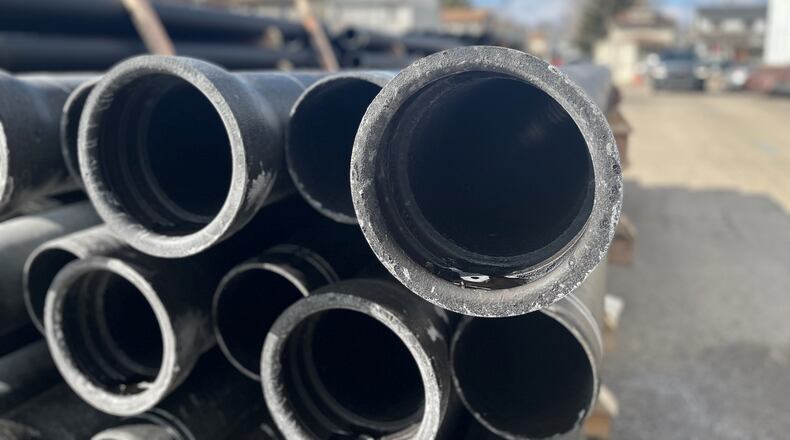Shortages of materials and equipment adding to clogged supply chains could be an enduring challenge, and local jurisdictions have few ways they can try to battle the squeeze.
“It’s not as if people have a tremendous backlog of volume of work,” said John Morris, CEO of the Ohio Valley Associated Builders and Contractors. ”It’s just they’re backed up in what they can do because they can’t get materials.”
Dayton last year had to cancel several vehicle purchase orders because dealers could not deliver, said Monica Jones, the city’s acting director of procurement, management and budget.
Dayton renewed the orders this year, but prices have gone up considerably since then, Jones said, and long delivery wait times are anticipated.
The city has found some alternatives, she said, but it also has had to keep vehicles in its fleet longer than anticipated, which often means higher repair and maintenance costs.
Cities and other buyers typically do not pay for vehicles until they are delivered, and purchasers face long waits and expect that prices at the time of delivery will be higher than when the orders were placed.
Tipp City ordered an ambulance in the spring of 2021 that might not be delivered until late this year, said John Green, the city’s finance director.
Orders of large trucks like ambulances, fire engines and salt trucks normally would take six to nine months to be fulfilled, but that’s not the situation these days.
The ongoing computer chip shortage evidently played a role in the delay.
Tipp City usually has three ambulances in its fleet, but one is permanently out of service and another has had mechanical problems.
The city has been forced to borrow ambulances from neighboring communities as it waits for its new medic unit to arrive, Green said.
Also, Green said, water and electric meters compatible with Tipp City’s meter reading system are nearly impossible to find, and so are electric transformers.
Troy has completely depleted its inventory of utility meters, which has caused delays in its replacement program, said Jill Rhoades, city engineer with Troy. The lead time for delivery of meters is about nine months, she said.
Emergency repairs also are a concern for Troy since it can take months or even much longer for parts to be delivered, she said.
Regular water main pipes have six-month waits for delivery, she said, and unless the city has the right-sized pipes or fittings in stock, it often has to figure out work-arounds.
Bellbrook ordered an ambulance as part of its 2022 capital improvement program, but delivery is expected to take about 15 to 18 months, which impacts planning and budget cycles, said City Manager Rob Schommer.
Also, he said, asphalt companies aren’t taking on additional bids or projects for the remainder of this season.
This is expected to delay a project intended to improve the drainage of the storm water system on Lower Hillside Drive.
Material shortages are strongly impacting the Associated Builders and Contractors’ construction backlog indicator, a barometer of the time it takes contracting businesses to start projects, said Morris, with the Ohio Valley Associated Builders and Contractors.
The association last week released results of a member survey showing its backlog indicator is 8.7 months. That number is consistent with local trends, Morris said.
“That’s not necessarily due to them holding the same volume of business, as much as it’s taking them longer to get materials,” Morris said. “If we weren’t experiencing supply chain issues, the backlog indicator would be shorter,” he said.
Many local communities and jurisdictions have been awarded American Rescue Plan Act money, and federal funds can be used for some capital investments.
Morris said this has led to increased construction demand, creating a bottleneck. More projects means more demand for materials and greater pressure on the supply chain.
Springboro had to delay replacing a water main on Fairway Drive, said Springboro City Manager Chris Pozzuto. The city hoped to get the project done this year, but that’s unlikely to happen because there is a 30-week wait to have ductile iron pipe delivered, he said.
Pozzuto said typically companies that handle pipe replacement projects have ductile iron in stock — which usually means there is no real lead time. But Springboro placed an order more than a month ago and the city so far has not been given a delivery date.
“It is a minor inconvenience now — but if this continues into the future it will greatly impact our ability to schedule projects during peak construction time,” he said.
The Franklin school district planned to open its new high school in August 2023. The current high school is being converted into the new junior high facility.
But the project completion date has been pushed back a semester due to a backlog of building supplies, said Superintendent Michael Sander.
The Franklin school district ordered structural steel in March but it likely will not be delivered until November.
The district also planned to acquire and install high-efficiency fans, but the lead time is 55 weeks, and district officials do not want to wait that long.
Instead, the district is looking at alternative and more traditional fans that right now have a 35-week wait for delivery, Sander said.
Messer Construction Co. recently said it was working with customers to deal with supply shortages, cost increases and high construction demand.
One option the company suggests is selecting different materials or finishes for projects, the company said.
Some materials are easier to get than others, as well as cheaper.
Stephen Sandherr, CEO of the Associated General Contractors of America, recently said it is still way too hard to acquire most materials.
“We are not out of the woods yet when it comes to high materials prices and supply chain problems,” he said.
Staff Writer London Bishop contributed to this story.





